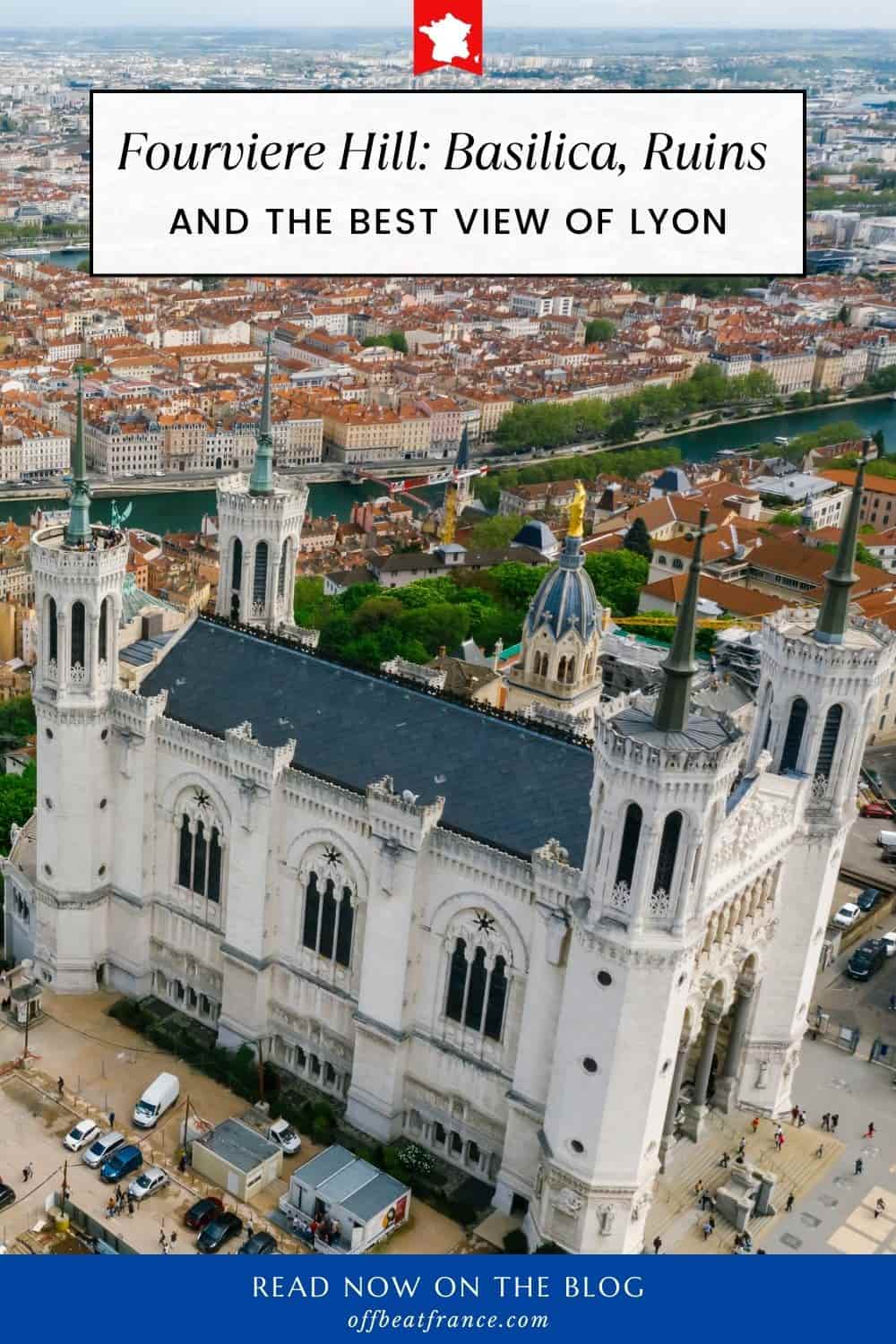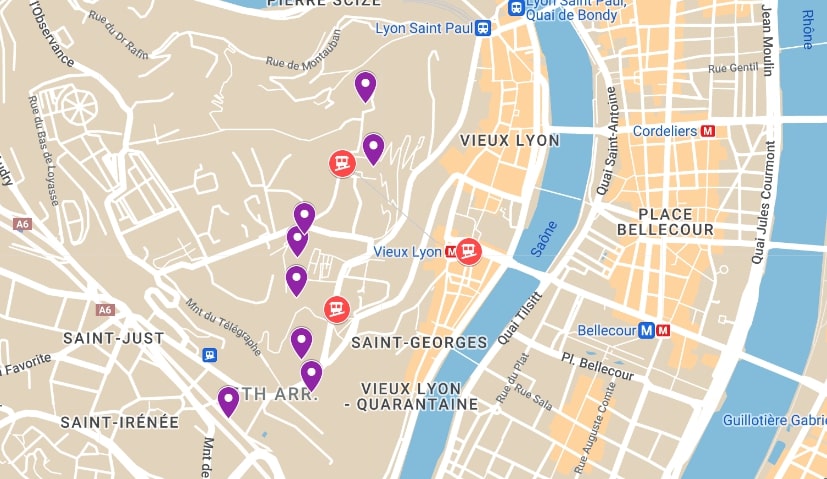Unsure about your French table manners? Click Here to download > > How to avoid these 10 food etiquette mistakes !
- Home ›
- Destinations ›
- Lyon ›
- Fourvière
Fourviere Hill: Basilica, Ruins, And The Best View Of Lyon
Published 24 October 2023 by Leyla Alyanak — Parisian by birth, Lyonnaise by adoption, historian by passion
I try to visit Fourvière Hill each time I go to Lyon: for the Basilica, of course, but also for the spectacular view and the amazing Roman ruins.
Staring up the 563 steps of Nicolas de Lange hill, you might decide to give up on getting to Fourviere Basilica before you even start.
I don’t blame you – I almost did!
But I persevered, reaching the top huffing and puffing. Long ago, when Lyon was fortified and before the stairs were built, sentries would walk back and forth along this path, searching for enemies. Today, joggers use it to train.
At the top is a surprise: not only a Basilica, but something that looks eerily like the Eiffel Tower. In fact, it is: the metallic Tower of Fourviere is in fact a replica of the Eiffel Tower’s top third. And just beyond is another surprise: a plunge into the past with the remnants of Lyon’s Gallo-Roman past.
Let’s take a stroll around Fourvière Hill, with the Saône River below, the Rhône River in the distance, and the city of Lyon unfurling in-between.
NOTE: Pages on this site may contain affiliate links, which bring in a small commission at no cost to you.
There are many reasons to visit Fourviere. The basilica and metallic tower and Roman ruins, of course, but also the fact that the hill is protected as a UNESCO World Heritage Site, which makes it a cultural site of note.
If nothing else, curiosity should drive you up here. When you’re in Lyon down below, just look up and you’ll see the basilica. Aren’t you just a little bit curious to see what’s up here?
Getting to Fourvière
These days, you don’t have to walk up if you don’t want to.
You can of course climb the steps at Nicolas de Lange behind the Gare Saint-Paul, as I did, or you can turn left at the bottom of the stairs and walk up the street.
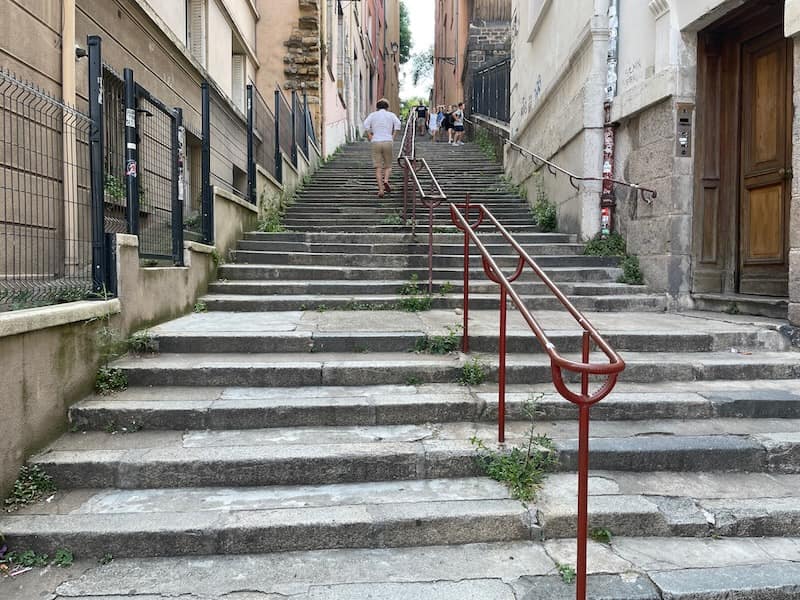
You could also take the Montée Saint-Barthélémy, the rue du Chemin Neuf and walk through the gardens of the Rosaire until you reach the basilica.
Or you could take the easy way out, as I do these days, and ride the funicular in just a few minutes. It starts from the other end of the Vieux Lyon old town, near the Saint-Jean Cathedral. This, in my humble opinion, is by far the best option. It’s quicker, you’ll have more energy at the top, and you can always walk back down if exercise is what you want.
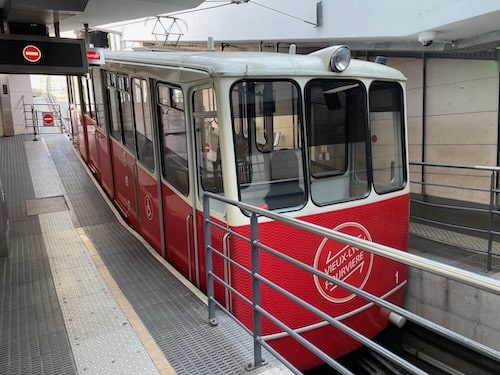
Locally the funicular is known as the Ficelle, or string, and it has been ferrying passengers up the hill for more than a century. In just a few minutes from Lyon Old Town, you’ll be whisked up to the top of the hill. Just make sure you take the funicular on the RIGHT if you’re headed to the basilica and the one on the left if you’re starting with the Roman ruins.
Lyon has another hill, by the way, Croix-Rousse, which is affectionately called the “hill that works” for the silk trade which once populated it. Fourviere Hill, on the other hand, is referred to as the “hill that prays”.
Basilica Notre-Dame de Fourvière
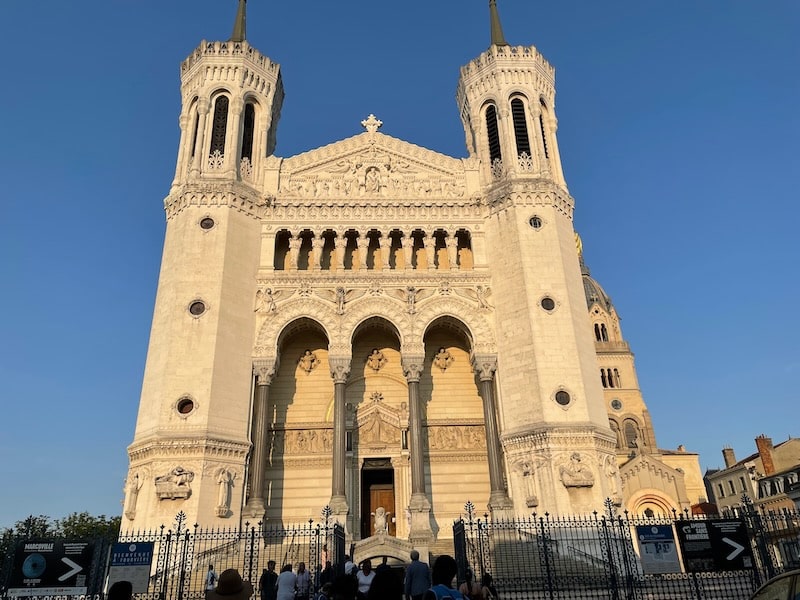
There has always been a church of some kind on top of Fourviere Hill.
The first one was built back in the 12th century, but was destroyed during the wars of religion that pitted Catholics against Protestants. It was rebuilt, dedicated to the Virgin Mary, and worship there helped ward off the many epidemics sweeping Europe during the Middle Ages.
In 1643, as plague was spreading from Provence, city authorities climbed to Fourvière on 8 September to ask for Mary’s protection. When the plague passed Lyon by, the city’s aldermen pledged to repeat their pilgrimage every year.
Plans to inaugurate a new statue of Mary on the hill on 8 September 1852 were wrecked by weather, and postponed to 8 December. Again, the weather wouldn’t cooperate but when authorities tried to postpone it a second time, the people of Lyon stepped in and lit small candles in their windows in honor of Mary. And so was born what would someday become the Lyon Light Festival. Still today, a procession from the Old Town to Fourvière takes place every 8 December.
➽ HOW DO YOU PRONOUNCE FOURVIÈRE? Click to listen.
Meantime, as the tradition celebrating the Virgin grew, space in the chapel atop Fourviere shrank. In 1871, the Prussians were winning the Franco-Prussian War and would eventually prompt the abdication of Emperor Napoleon III. Lyon trembled and again, prayed to Mary, hoping to spare the city from the advancing troops. The prayer was heard and Lyon was spared.
To thank her, Lyon’s archbishop decided to build a basilica.
Things moved quickly. A peace treaty with the Prussians was signed in 1871, and tby 1872, the cornerstone of the the Basilique Notre-Dame de Fourvière had been laid.
WHAT DOES FOURVIERE MEAN?
No one knows for sure, but it is believed to come from “Forum Vetus”, which means Old Forum in latin. Since the Romans chose Fourvière Hill when they founded Lyon and the city had a central forum, like all Roman cities, this is a plausible answer.
Don’t confuse the hill with the tunnel of the same name. The Tunnel de Fourvière was built in 1971 to reduce traffic in central Lyon and to encourage travelers from Paris to Provence to stop in Lyon. It’s narrow and traffic is often snarled, so visitors opt for alternative routes that bypass the city. Avoid it if you can…
The Basilica from the outside
Unlike most church buildings in France, the basilica is relatively recent. Rather than Gothic or Renaissance, its “modern” approach is more a mix of Byzantine and Romanesque.
However you feel about this mix of styles, your first impression will be strong as you exit the funicular station: two giant towers (there are four in total, representing the four cardinal points) rising towards the sky, alabaster brightly contrasting with the sky.
Before going inside, you might want to circle the basilica and step out onto the terrace for one of the most stunning views of Lyon you’ll have on your trip — a tapestry of districts, each with its own distinct character, stitched together by the winding rivers Saône and Rhône.
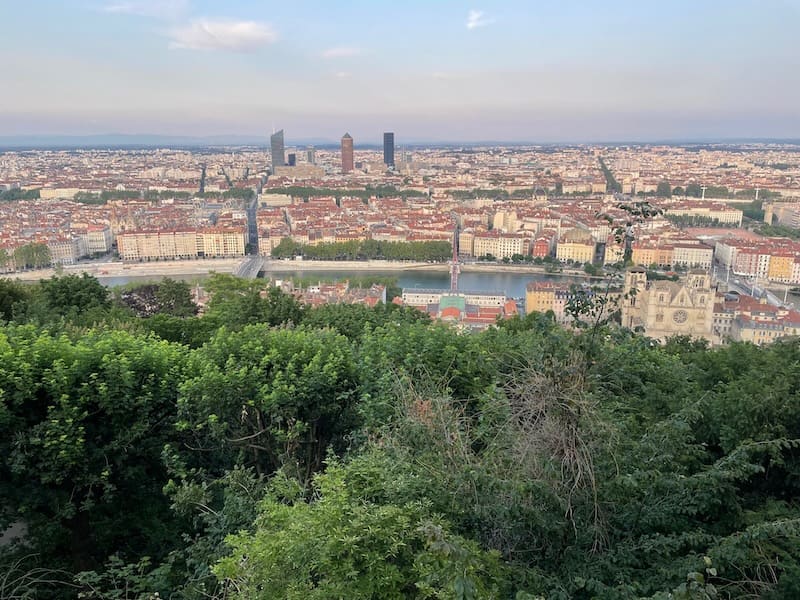
For an even better view, take one of the rare tours organized by the basilica that climb to the rooftop and from where you’ll snap photographs unlike any others. You can find more information here (the tours are in French but the view is universal).
The Basilica’s interior
Heading inside, a medley of mosaic and stained glass reflects the sunshine that manages to filter through.
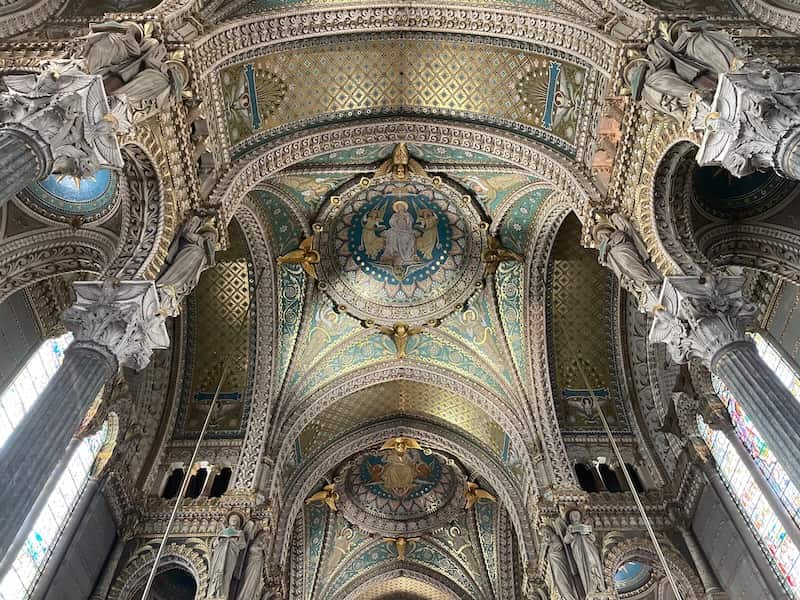
Predictably, there are plenty of homages to Mary, including a statue crowned in gold. Or at least it was gold until the crown was stolen in 2017 and replaced with a replica. Interestingly, this replica dates back to 1940. It was designed to replace the original crown, which was hidden as the Nazis approached.
The Crypt: A hidden sanctuary
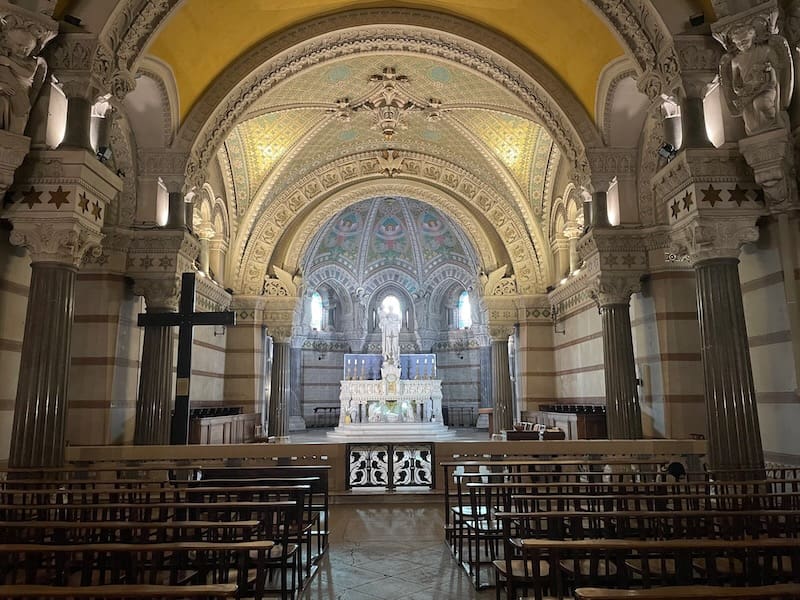
Head down the (amazing) stairs inside the basilica to the lesser-known but equally captivating crypt (known as the Lower Church). This is a church in itself, which means the basilica is actually made up of two churches. The Lower Church is dedicated to Saint Joseph, but you wouldn’t know it given the number of Marys it contains, many of them donated by other countries.
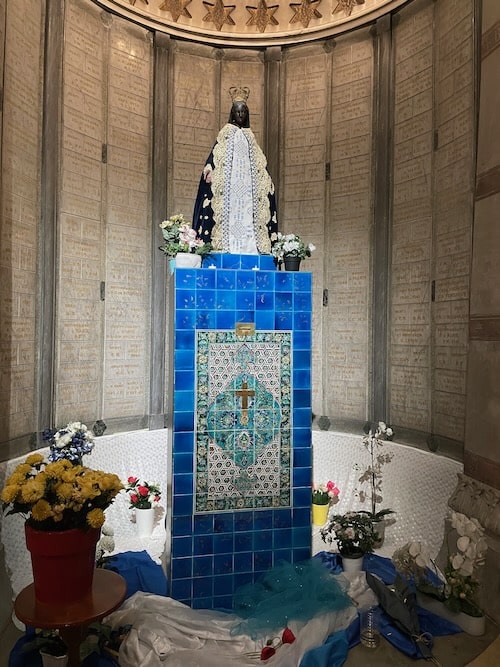 |
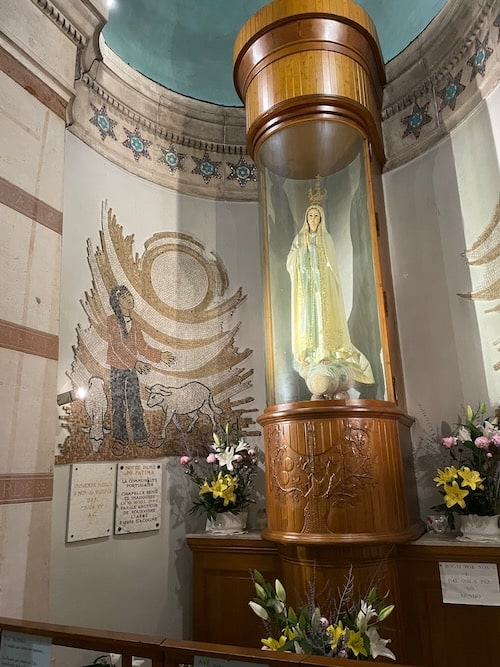 |
The Rosary Garden
I mentioned the Eiffel Tower lookalike earlier: it’s not quite a lookalike, but a replica of the top of the tower. Initially built to house a restaurant, these days it is a communications tower. You can’t visit it, but it makes for an intriguing photo. Turn right when you leave the basilica through the front door and keep looking up – it will guide you.
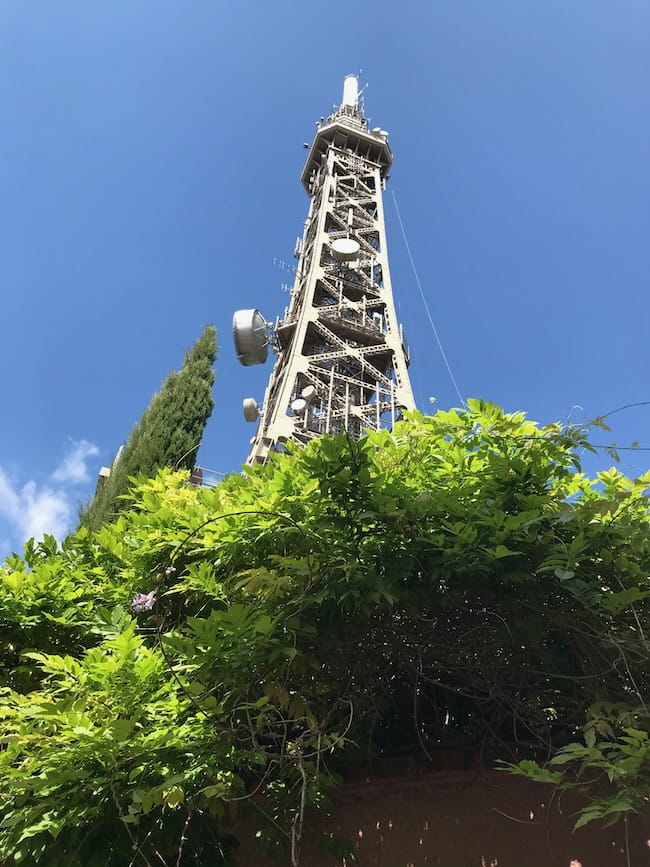
When you’re finished, retrace your steps and head downhill from the basilica entrance’s left.
Lugdunum, the first Lyon on Fourviere Hill
The Roman ruins of Lugdunum are among France’s premier Gallo-Roman sites, and one of the main reasons people climb up Fourvière.
Stone Age remnants have been found here, but what you really want to see are Lyon’s beginnings as a crossroads, when Julius Caesar was busy conquering Gaul. Barely 30 years after its founding in 43 BCE, Lugdunum became the political, religious and economic capital of Roman Gaul.
Things got messy when Christians arrived in Rome. The Christian community grew but they refused to pledge allegiance to Rome and its emperor. Many would be arrested and executed, including Saint Blandine, Lyon’s patron saint. But Lyon’s fortunes would wane, and it would lose its status as the capital of Gaul.
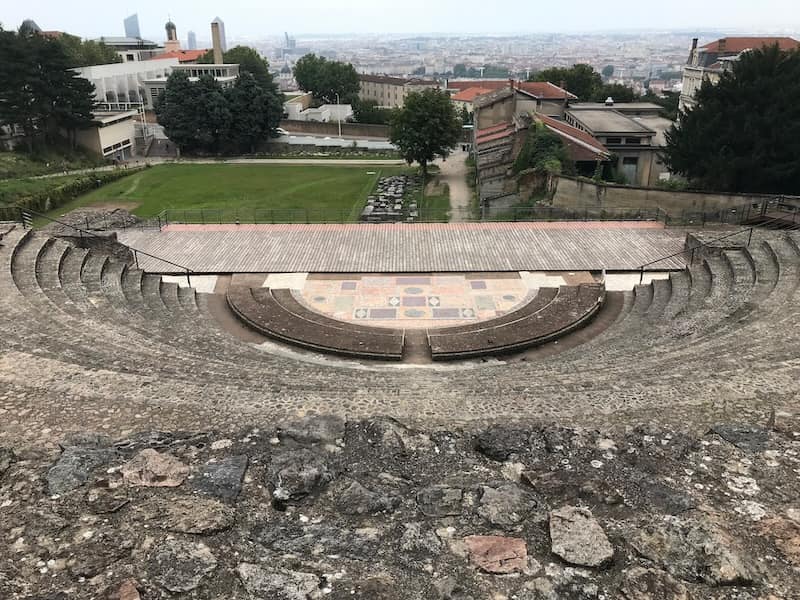
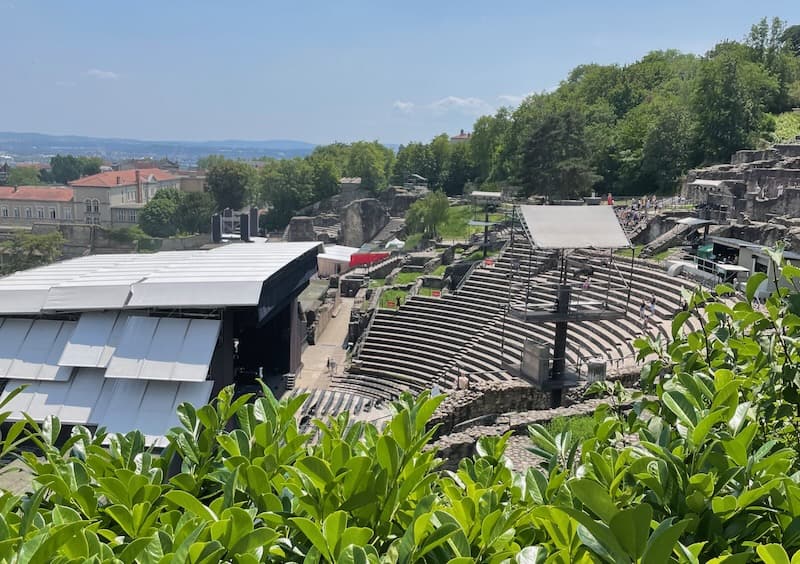
Plenty is left from those days, like a Roman amphitheater that once seated upward of 10,000 spectators. Come summer, it pulsates with the energy of Les Nuits de Fourvière, an annual arts and music festival. To attend a performance here is to witness a confluence of eras, tapping to the rhythm of rock music while sitting on seats which once welcomed Romans clad in robes.
Right next to the amphitheater is the Odeon, also a theater but far smaller, for 3000 or so people.
To fully plunge yourself into Lugdunum’s history, you’ll have to visit Lugdunum Museum, which curates two millennia of artefacts. Built into the hill, the museum is architecturally unique and its collection a fascinating stroll through life in Gallo-Roman times. You’ll see some particularly impressive mosaics.
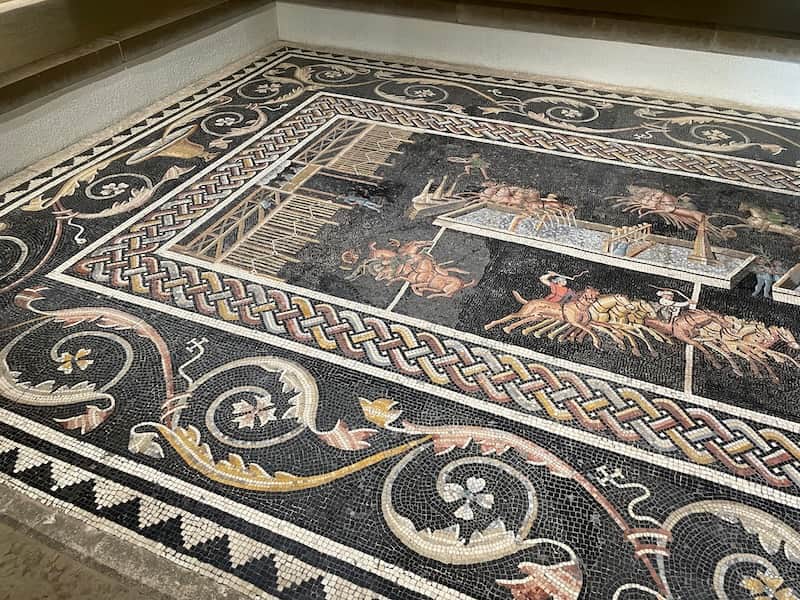
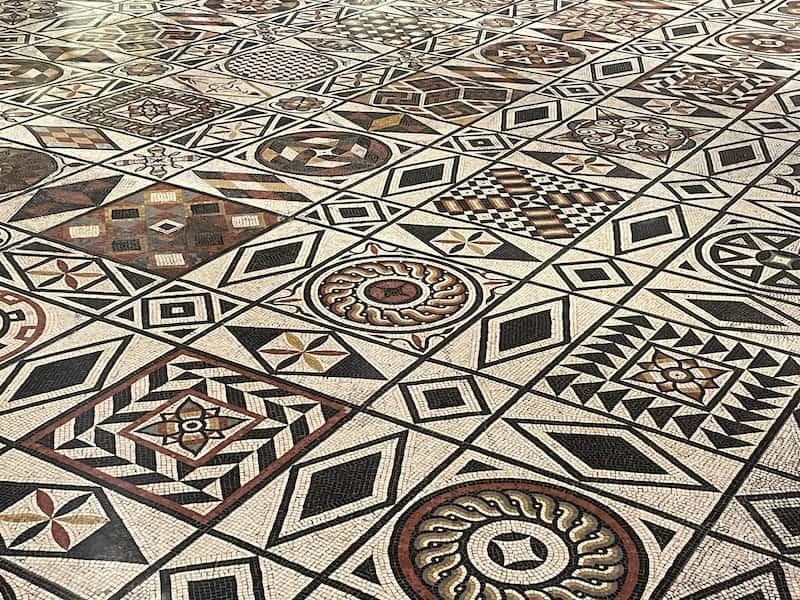
Video: Lyon Fourvière Hill
Where to eat on Fourviere Hill
It’s hard to find an area of Lyon without good restaurants, and Fourviere is no exception. Here are some I’ve chosen for you which I think you’ll enjoy.
Bulle – 9 Place de Fourvière
It’s what I like to call affordable gastronomy. Bulle belongs to Michelin-starred and Meilleur Ouvrier de France (the organization that anoints France’s top culinary artists) Guy Lassausaie. If you want the same view as the one you get from behind the basilica, this is it. In fact, it’s right on the basilica grounds, on the side.
Les Telephones – 23 Rue Roger Radisson
This is the restaurant of the Hôtel de Fourvière, and both are located in a former convent, so you’ll love the surroundings.
Le Coquemar (many smaller French restaurants use Facebook rather than build their own websites) – 25, montée Cardinal Decourtray
Around the corner and down the hill from the basilica, you can sit on the terrace (or indoors) and take a lunch break between the basilica and the Roman ruins. It’s only two blocks away, and you can actually see the basilica from the windows.
La Salle a Manger – Esplanade de Fourvière
I haven’t tried this one but I hear it’s great value for money. It’s a student training center for young people who need to reintegrate society and find work, so service may be a bit slow and uneven but prices look fabulous. It’s only open for lunch, and you can reserve here.
Têtedoie – 4 rue du Professeur Pierre Marion
This is actually three restaurants in one, depending on the season: a gastronomic restaurant, a bistro, and a rooftop restaurant. I first met Christian Tetedoie at the Lyon Street Food Festival, where I stood in line to taste his pan-fried foie gras, with which he rose to the top of my list of Lyon chefs.
And finally, this is Lyon. There is food on every corner, and you’re only minutes away from Old Lyon and its many eateries.
Where to stay in Lyon
There are a few hotels on or around Fourviere Hill, but the vast concentration is in Lyon below. Have a look at the map to spot your preferred area. The Presqu’île is where you’ll find the most accommodation, since it is the commercial heart of Lyon. Some of you may like to stay in the Old Town, but bear in mind it is crowded and noisy, and cars can only go so far.
If you’re arriving by train, here are some hotels near Lyon train station. If you’re flying in, you may also end up at the train station since the direct Rhônexpress tram from the airport ends at the Part-Dieu station, Lyon’s largest train station.
The public transportation system is so efficient you can pretty much stay anywhere – nothing will be beyond reach. Here’s more about Lyon’s public transport.
Ready for your Lyon trip?
Here are some suggestions to make your visit even more enjoyable!
TOP LYON CITY TOURS
➽ Vieux Lyon 4-hour Food Tasting Tour - for inveterate foodies and gastronomes
➽ Discover Lyon Walking Tour - to explore the essence of the city
LYON DAY TRIPS
➽ Golden Stones Beaujolais - heart of the Golden Stone villages for wine lovers
➽ Northern Côtes du Rhône - meeting the winemakers
➽ Beaujolais and Pérouges - wine tasting and a medieval village visit
WHERE TO STAY IN LYON
➽ Villa Florentine - stunning 5-star luxury overlooking the entire city
➽ Mi-Hotel Tour Rose - perfect apartments in historic Vieux Lyon
➽ Fourvière Hotel - elegant simplicity in a former cloister
➽ Hotel du Théatre - budget option in the heart of the classical district
Renting a car in Lyon? Compare prices here.
Traveling here by train? Book your ticket here.
To see the city, don't forget to book your Lyon City Card.
Before you go…
Exploring Fourvière Hill is just one of the many exciting things to do in Lyon − on your way down from the hill, stop and explore a few of Lyon's traboules, or secret passages. Lyon is nothing if not full of surprises.
Did you enjoy this article? I'd love if you shared it!
